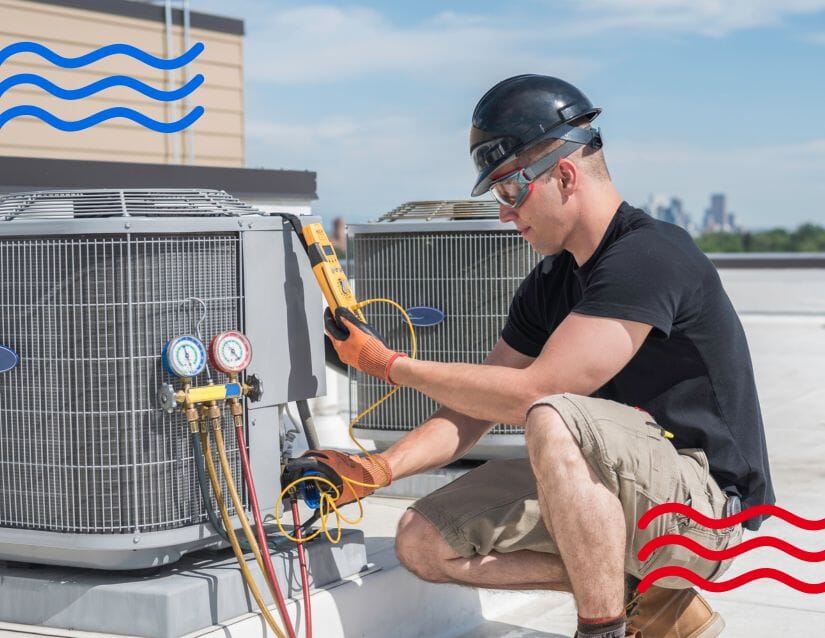Guide to Commercial HVAC in Sacramento, CA


CABS HVAC
Like what you're reading?
Leave us a review and let us know!
Leave us a review to help us reach more people with educational home services content.
In this Article:
- What Is Commercial HVAC?
- Types of Commercial HVAC Systems
- How Does Commercial Heating and Cooling Work?
- Zones, Controls, and Managing Your Commercial HVAC System
- Humidity and Moisture Control in Commercial HVAC
- Indoor Air Quality in Your Commercial Property
- Maintaining Your Commercial HVAC System
- Why Choose CABS For Your Commercial HVAC Job?
Looking for a trusted, locally owned company in the greater Sacramento area to perform your next commercial HVAC project? Look no further. Give CABS Heating and Air Conditioning a call today, and to get a no-obligation quote for HVAC maintenance, repair, replacement or installation!
Now, read on if you’re looking for more information about commercial HVAC systems…
If you’re the owner of a commercial property or business, you have a ton of things to worry about. Tenants, upkeep, billing, staffing, infrastructure, and more. HVAC should not be among those concerns, but it often is.
Heating and cooling for commercial properties can be time-consuming and expensive. Here at CABS Heating and Air Conditioning, our job is making that process as smooth as possible so that you can get back to running your property or business.
This article should help to demystify the process and give you some actionable steps for managing your commercial HVAC system. Better still, if you’re in the Sacramento area, we’d love to schedule a time to meet and talk through your issues and upcoming projects. We believe we can help any business owner looking for affordable, comfortable and reliable commercial HVAC in the greater Sacramento area.
What Is Commercial HVAC?
Any HVAC system that services a commercial property such as an office building or business is considered commercial HVAC. It includes heating, cooling, air quality and ventilation of the building(s).
Often there are additional considerations for commercial properties that don’t exist for residential homes. For example, the scale can be wildly different. A convention center might need dozens or hundreds of separate systems, while a small shop could be even easier to heat and cool than some single-family homes.
Governmental, zoning, and safety restrictions can also vary by business type and occupant levels in the building.
Major Components of a Commercial HVAC System
The major components of commercial systems include:
- Cooling Unit(s)
- Heating Unit(s)
- Ductwork
- Thermostat(s) or other controls
- Ventilation Equipment
Each of those could be broken down into smaller components, but they are the “hubs” of your system that will regulate all of the variables mentioned above.
With many, there will be more than one unit and control mechanisms. Ventilation equipment might be controlled separately from temperature gauges, and if there are different areas (zones) of your property, they may all have separate controls. In some sophisticated commercial systems, cooling and heating units are linked, and so there are some universal controls that will affect all of them.
Types of Commercial HVAC Systems
There are a handful of types of commercial HVAC systems, and each can be the best options depending on the particulars of your needs:
- Packaged Systems - all-in-one “packages” that contain all equipment in one location.
- Split Systems - there are actually additional types within this sub-category, “single split” and “multi-split.” The appeal of multi-split is that multiple units are tied into the same subsystem, allowing them to synchronize cooling efforts and pick up the slack if one malfunctions. Single split systems are generally used for smaller spaces.
- Rooftop Systems - while fundamentally similar to some other system types, a protective casing is usually included with these since the units are exposed to the elements more than usual. This requires rooftop space and also access to ductwork systems that travel throughout the building.
- VRF and VRV Systems - Variable Refrigerant Flow (VRF) and Variable Refrigerant Volume (VRV) systems are ductless, and provide incredibly efficient heating and cooling. The compressors and condensers - traditionally housed in separate units - are in the same unit here, and it’s only the refrigerant that travels to absorb or expel heat. The cost can be higher on this type of unit, and the construction considerations are different, but they’re becoming increasingly popular.
How Does Commercial Heating and Cooling Work?
The basics of heating and cooling commercial properties are the same as for residential systems. Regulate the humidity, temperature, and airflow throughout the property.
The specifics of those are where there are some significant differences between residential and commercial jobs. We detail several of them below, which can inform your decision-making for your next project.
Zones, Controls, and Managing Your Commercial HVAC System
Zones refer to discreet areas of a property that need to be managed via HVAC systems. In an office building, this might be each floor. In a hotel, you’ll likely have a separate control system for each ballroom, and others for individual rooms and common areas.
How many zones your property has, and what the needs are of each, is a big part of determining what type of system you need, what your ventilation needs are, and more.
Similarly, control systems need to exist for each of these. And it can be annoying when there are separate controls in different areas, unless this is intended (e.g. controls for each floor of a building that the employees on that floor manage).
The electrical needs that will connect multiple zones to a master control deck can be considerable. Hybrid control solutions can be considered, but an experienced commercial HVAC contractor will walk you through options and their various prices, pros and cons.
Commercial vs. Residential HVAC: What’s the Difference?
Here at CABS, we service residential properties as well as commercial HVAC. Is there a difference?
On a fundamental level, no. We provide efficient heating and cooling solutions using the same fundamental equipment types and technologies.
However, there are some huge differences that change these jobs. Some common ones are listed below:
Location of the System
A residential home often has the primary HVAC unit in the basement. Commercial properties will often have outdoor, fenced areas for HVAC units, or they’ll be located on the roof.
This creates new physical issues to work with, since the thermodynamics of airflow depend on things like elevation and pressure.
Zoning
Residential homes can have zones too, but it’s a lot less common. More frequently, a single HVAC system services the entire area.
Most commercial properties need multiple HVAC zones that are separately controlled and compliment each other. Even the most powerful heating and cooling unit can only adequately treat a certain sized area (usually between 3,000-5,000 square feet). Beyond that, zoning is often a better solution.
Ventilation Complexity
The ventilation needs of commercial HVAC tends to be a lot higher. The size, volume and construction of ductwork systems becomes a lot more important not just for providing heated or cooled air, but for air circulation in general.
If you look up in most airports, conference centers, or similar buildings, you’ll often see massive networks of interconnected ductwork. Proper ventilation is exactly what that’s for.
Humidity and Moisture Control in Commercial HVAC
Indoor spaces need an enormous amount of humidity removed during the warmest months. This can put a strain on even powerful HVAC systems.
High humidity is the cause of loads of problems, but it’s also going to make your commercial property uncomfortable for any tenants, employees or visitors. So its removal becomes important for HVAC.
This means drainage systems. Pipes, plumbing, flues. The exact methods vary, but a buildup of excess moisture can even become health & safety issues if left unchecked.
An HVAC contractor with experience in drainage systems and how they have to work in conjunction with HVAC is an essential part of making sure your project goes smoothly.
Indoor Air Quality in Your Commercial Property
Humidity is equal to heat for the human body, and so a large part of
Keeping the air clean is also a major concern. What if you own a restaurant with a large kitchen that regularly sends all sorts of smells and smokes into the air? Or your property regularly has hundreds or thousands of people in it per day? The air quality needs of these commercial properties are greater than others.
Filtration is your first line of defense. HEPA-certified filters should be the norm, as this will allow a lot of particulates to be captured, including some airborne bacteria and viruses that will undoubtedly flow through your property’s air eventually.
Regular maintenance is the second key, and this includes filtration changes and monitoring systems to ensure they’re working optimally.
The last factor is ventilation. Bringing fresh air and circulating air out is key, and this requires careful ductwork design and ventilation management. Particularly for specialized properties, ventilation systems designed to flush the air from areas and circulate in new air should be considered to maintain healthy, clean air.
Maintaining Your Commercial HVAC System
Maintenance (aka tune-ups) are essential to any system, but it’s even more true of commercial properties.
Commercial HVAC can be expensive. Repairs can be tens of thousands if the property is large enough and the damage is extensive enough. This isn’t a situation you want to find yourself in.
Commercial systems often operate more frequently than residential systems. The typical recommendation for a homeowner is to get each major piece of equipment
For commercial properties, that’s not enough. Twice per year, per system should be the minimum, and most business owners should be considering quarterly checkups to ensure system health.
Why Invest in Your Commercial Property’s HVAC?
When we talk to homeowners, we emphasize the long-term benefits of upgrading their HVAC system. The same is true for commercial properties, but the financial and comfort incentives are even bigger since you’re serving more people.
Costs can mount with older or incomplete systems. Issues with the building itself can occur from customers, employees, or regulators. And a well-maintained, efficient system can save you thousands in heating and cooling costs per year.
It can be hard NOT to see the benefits once you truly know what you’re gaining with quality HVAC.
Why Choose CABS For Your Commercial HVAC Job?
At CABS Heating and Air Conditioning, we pride ourselves on our quality work, and that includes commercial, multifamily and residential properties.
We will work with your project needs to create a timeline and budget that meets your expectations. We have electrical, plumbing and HVAC experience that all work together to provide holistic knowledge of comfort systems for your commercial property.
And we’re among Sacramento’s most-trusted heating and cooling experts. Give us a call to start the process. We look forward to speaking with you!
Sacramento’s Most Trusted Air Conditioner Services Company
Earning your trust and your business is our top priority. Contact us to see why we’re Sacramento’s most trusted cooling specialists.
